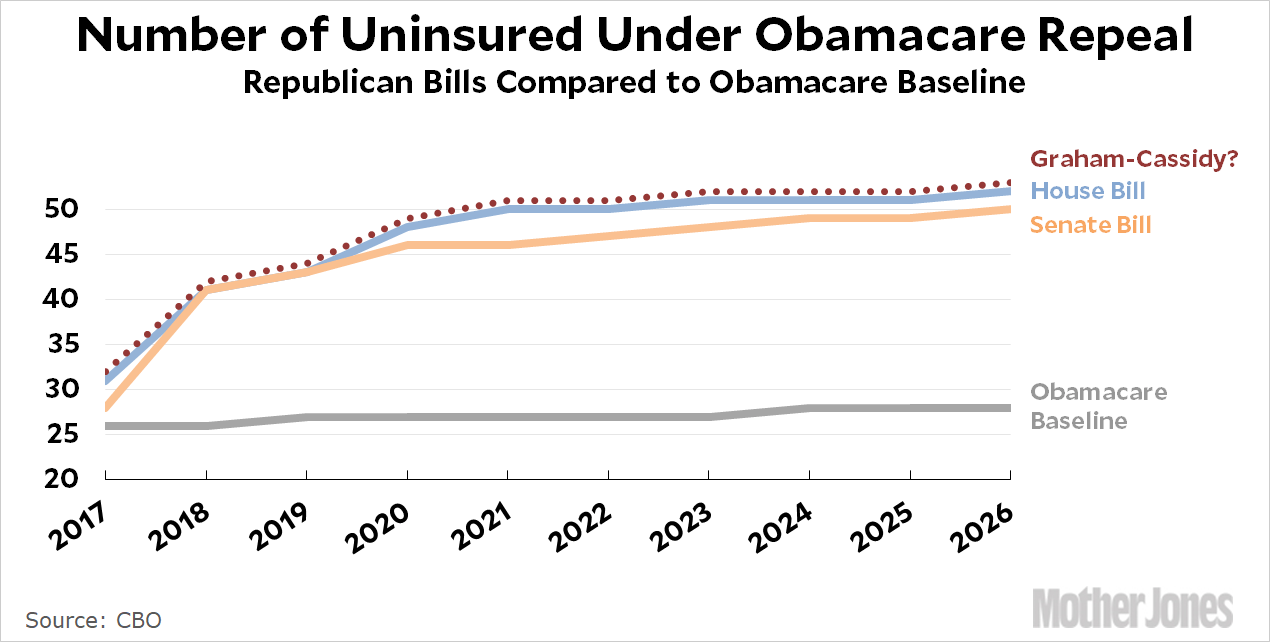I suppose you have to give Republicans credit for persistence: they’re now trying yet again to repeal Obamacare. The first attempt ended when Paul Ryan couldn’t round up the votes in the House. The second attempt ended when Mitch McConnell couldn’t round up the votes in the Senate. Now we have Graham-Cassidy, which is considerably worse than either of the first two. Literally its only selling point is that it’s not Obamacare.
The plan for passage is similar to Repeal 2.0: do it fast before the CBO can tell us how many people would lose health insurance if it passes. But we don’t really need the official CBO score for that since we already know that Graham-Cassidy would eliminate the individual mandate and slash spending on Medicaid. Those two things account for the vast bulk of CBO’s score, which means that its score of Graham-Cassidy will be very similar: about 23 million people would be tossed off their insurance plans over the next decade.
But could it be even worse? Sure. Graham-Cassidy also eliminates protections for pre-existing conditions, which would make insurance unaffordable for even more people. The CBO score could easily end up at 25 or 26 million.

The clever part of the Republican plan is that the public might not ever see screaming headlines about this. Even though it’s plainly obvious what Graham-Cassidy would do, mainstream news organizations aren’t allowed to just say so. They have to wait for “official” numbers. Those may or may not come before the bill gets a vote.
You can read more of the details about the bill elsewhere, but here are the big takeaways:
- Basically turns everything over to the states. It gives each state a chunk of money and allows them to do nearly anything they want with it.
- Eliminates protections for pre-existing conditions even though it says otherwise. The trick is that although insurers are required to cover everyone, they can charge anything they like. In practice, this means a pre-existing condition will prevent you from ever getting insurance.¹
- Slashes spending on Medicaid and turns it into a block grant.
- Slashes federal subsidies and turns them into a block grant too.
- Allows states to eliminate Obamacare regulations governing essential medical benefits. This means it’s back to reading the fine print if you buy a medical policy. Maybe it covers doctors’ visits, maybe it doesn’t. It all depends on what your state’s governor decides.
Now, Republicans still have big problems remaining. First, the bill has to be passed within this fiscal year, which ends on September 30. That’s 11 days away. They have to get at least a preliminary CBO score so that they officially know that Graham-Cassidy would reduce the deficit (required under rules for reconciliation bills). And then they have to get the OK from the Senate parliamentarian. This could be a big problem since the parliamentarian is unlikely to agree that the new rules about pre-existing conditions meet reconciliation requirements. And if Graham-Cassidy has to be changed to require coverage of pre-existing conditions for everyone at the same price, it would blow up the bill and rquire a new CBO score.
The odds are against this happening within 11 days. But it’s still possible. Republicans really, really want to stick it to Obamacare no matter what the cost. Liberals better start manning the barricades again.
¹Unless you’re one of the lucky ducks in a blue state that decides to keep Obamacare rules intact. But even that might not matter, since funding in blue states would be cut way back and they probably couldn’t afford to offer Obamacare-style protections.

















